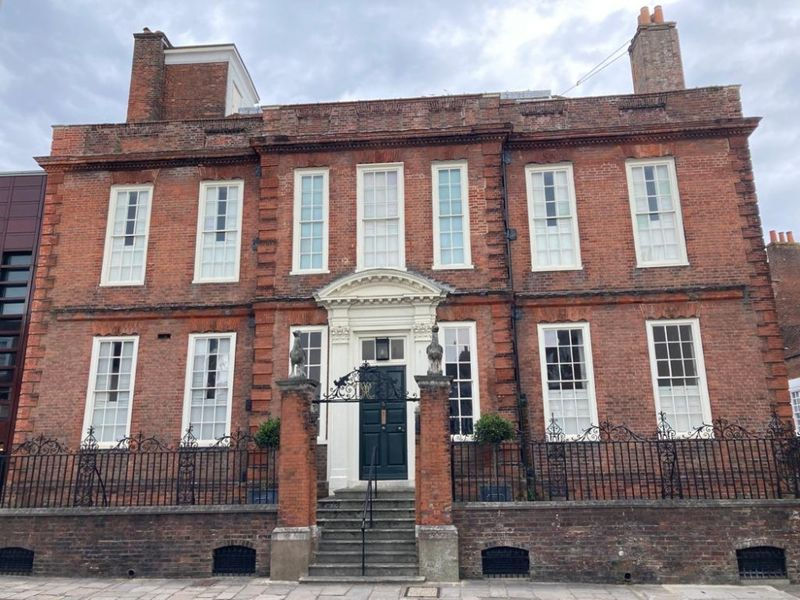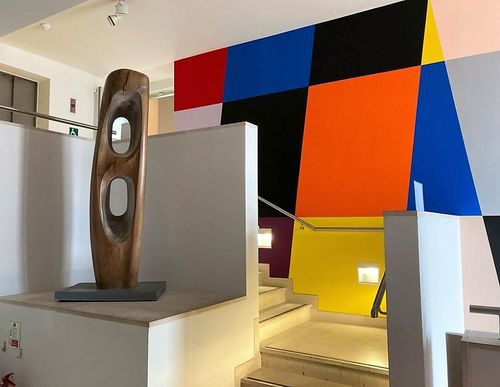The Pallant House Gallery in Chichester on the south coast of Hampshire, is a great discovery for the art lover. It’s of particular delight to the Slow Traveller because of the wide open expanses of the various rooms – allowing for plenty of unhurried time and space to view each painting individually without crowds or pressure.

It’s an unusual gallery – the building is a mixture of the original Queen Anne townhouse built in 1712 and an award-winning contemporary extension added in 2006. It was opened in 1982 and today has one of the most significant collections of Modern British Art in the UK. It has a permanent collection but regularly stages temporary exhibitions of some of Britain’s most iconic modern artists.
The permanent exhibition is very cleverly curated to display each work of art to maximum advantage. The ceilings are high, the walls are light, the floors – stone tiles, wooden blocks, rush carpet – are deliberately neutral and plain, adding to the sense of open and uncluttered space.

Against the walls are also displayed some single items of 18th century mahogany furniture – which, initially, you might assume would not work well with modern art – but in fact each piece adds to the sense of grandeur within the rooms.
Nothing detracts from a study of the paintings, each one is enhanced by its setting. Yet, for all the tranquillity, these galleries have the power to surprise and startle. As you turn a corner or enter a new room you can be suddenly amazed by the unexpected – a Barbara Hepworth statue such as Single Form, Nocturne, Peter Blake’s striking and dramatic red panel entitled Love or the stunning and colourful Composition for a Staircase by Lothar Gotz.
The permanent collection takes the visitor from the early 20th century up to the present day, and a few objects from the comprehensive collection are mentioned here. The first galleries contain works as such as The Garden Path by Spencer Gore, one of the many talents coming from the Slade School of Fine Art at the turn of the 19th century, and Bathers by the Pond by Duncan Grant, a composition painted at Charleston, the artistic home of the Bloomsbury Group.
After the First World War, artists such as Paul Nash, Ben Nicholson and Mark Gertler looked for inspiration in traditional landscapes, yet the horror of war returned again with artists such as Graham Sutherland whose War, Devastated Valley in France is on display here. One of the largest and most powerful paintings is that of The Estuary by Michael Andrews which has a sense of aerial perspective over fishermen, seeming to suggest their relative insignificance to the power of the sea and the vastness of the land around them. The theme of human fragility in the force of nature is reflected in Bill Woodrow’s bronze Regardless of History.
The exhibition continues with artists whose work reflects Cubism, Neo-Romanticism to Pop and Neo-classicism to contemporary art. Bridget Riley’s Study for Measure 51 and 46 , inspired by pointillist artist George Seurat is here, as is the work of the French Cubist painter Jean Metzinger entitled The Scaffolding. Two portraits stand out – Lucian Freud’s Portrait of a Girl and the alarming and tortured self-portrait by Victor Willing.
Along with the permanent exhibition, new exhibitions are regularly introduced. In 2022 the focus is on Glyn Philpot’s work. There will always be something to attract the visitor and encourage new ways of thinking and looking at the world.
Visiting Pallant House
Address: Pallant House Gallery, 8 – 9 North Pallant, Chichester, PO19 1TJ
How to get there:
Chichester Railway Station is an 8 minute walk away.
There are 10 car parks within easy walking distance
The bus station is a few minutes walk away. Buses from Felpham, Bognor Regis, Portsmouth and Littlehampton.
Opening Times: Tuesday – Saturday 10am – 5pm
Sunday/Bank Holiday 11am – 5pm
Ticket Prices:
Adults £12.50,
Art Fund Members £6.50.
Half price when the gallery is changing exhibitions.
The Courtyard Café is available on site for coffees, lunch and afternoon tea.

















Comments